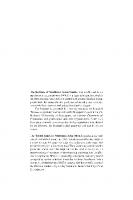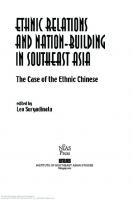Ethnic Groups Across National Boundaries in Mainland SEA Southeast Asia 9789814379366
The six essays on specific ethnic groups are written by five anthropologists and a linguist, all of whom have had long e
241 28 9MB
English Pages 127 [204] Year 2018
Contents
Foreword
Contributors
Acknowledgements
Introduction Definition, Innovation, and History
Language and Ethnicity The Man in Burma and Thailand
Thailand and the Tai Versions of Ethnic Identity
A Comparative Study of Structure and Contradiction in the Austro-Asiatic System of the Thai-Yunnan Periphery
Ethnicity, Nationalism, and the Nation-State The Karen in Burma and Thailand
Capitalism and the Structure ofYao Descent Units in China and Thailand A Comparison ofYouling (1938) and Pulangka (1968)
Squatters or Refugees Development and the Hmong
Afterword "Ethnicity" and Anthropology
Index
Recommend Papers

- Author / Uploaded
- Gehan Wijeyewardene (editor)
File loading please wait...
Citation preview
Ethnic Groups across National Boundaries in Mainland Southeast Asia
The Institute of Southeast Asian Studies was established as an autonomous organization in 1968. It is a regional research centre for scholars and other specialists concerned with modem Southeast Asia, particularly the many-faceted problems of stability and security, economic development, am\ political and social change. The Institute is governed by a twenty-two-member Board of Trustees comprising nominees from the Singapore Government, the National University of Singapore, the various Chambers of Commerce, and professional and civic organizations. A ten-man Executive Committee oversees day-to-day operations; it is chaired by the Director, the Institute's chief academic and administrative officer. The Social Issues in Southeast Asia (SISEA) programme was established at the Institute in 1986. It addresses itself to the study of the nature and dynamics of ethnicity, religions, urbanism. and population change in Southeast Asia. These issues are examined with particular attention to the implications for. and relevance to, an understanding of problems of development and of societal conflict and co-operation. SISEA is guided by a Regional Advisory Board comprising senior scholars from the various Southeast Asian countries. At the Institute, SISEA comes under the overall charge of the Director while its day-to-day running is the responsibility of the Co-ordinator.
Ethnic Groups across National Boundaries •
Ill
Mainland Southeast Asia edited by
Gehan Wijeyewardene Australian National Uni1·crsit\'
Issues in Southeast Asia I5EA5 Social INSTITUTE OF SOUTHEAST ASIAN STUDIES
Cover Yao e/derfi·om the l'illage of Pulangka. Chiangrai prm·ince. northern Thailand. Photograph by courtesy ofDouglas Miles
Published by Institute of Southeast Asian Studies Heng Mui Keng Terrace Pasir Panjang Road Singapore 0511 All rights reserved. No part of this publication may be reproduced, stored in a retrieval system, or transmitted in any form or by any means, electronic, mechanicaL photocopying, recording or otherwise, without the prior permission of the Institute of Southeast Asian Studies. © 1990 Institute of Southeast Asian Studies
Cataloguing in Publication Data Ethnic groups across national boundaries in mainland Southeast Asia I edited by Gehan Wijeyewardene. I. Ethnicity--Asia, Southeastern. 2. Ethnicity--Burma. 3. Ethnicity--Thailand. 4. Ethnicity--Laos. 5. Ethnicity--China--Yunnan. 6. Ethnicity--China--Guangdong. I. Wijeyewardene, Gehan. II. Institute of Southeast Asian Studies (Singapore) GN495.6E841 1990 sls90-008778 ISBN 981-3035-57-9 (soft cover) ISBN 981-3035-61-7 (hard cover)
The responsibility for facts and opinions expressed in this publication rests exclusively with the authors and their interpretations do not necessarily retlect the views or the policy of the Institute or its supporters. Printed in Singapore by Kin Keong Printing Co. Pte. Ltd.
Contents
Foreword Contributors Acknovt·ledgements
1'1
1. Introduction: Definition, Innovation, and History Gehan Wijeyewardene 2. Language and Ethnicity: The Mon in Burma and Thailand Christian Bauer
14
3. Thailand and the Tai: Versions of Ethnic Identity Gehan Wijeyewardene
48
4. A Comparative Study of Structure and Contradiction in the Austro-Asiatic System of the Thai-Yunnan Periphery Cholthira Satyawadhna
74
5. Ethnicity, Nationalism, and the Nation-State: The Karen in Burma and Thailand Ananda Rajah
102
6. Capitalism and the Structure of Yao Descent Units in China and Thailand: A Comparison of Youling (1938) and Pulangka (1968) Douglas Miles
134
7. Squatters or Refugees: Development and the Hmong Nicholas Tapp
149
8. Afterword: "Ethnicity" and Anthropology Ro:anna Lilley
173
Index
185
Foreword
Ethnic and religious issues have, in the last few decades, confounded many social analysts by refusing to disappear. The "liberal expectancy" among social analysts used to be that modernization would blur ethnic distinctions, achievement would replace ascription and particularistic criteria, and wideranging communication and education systems would homogenize populations. The "radical expectancy" was that differences in religions, languages, and culture would be swallowed up, perhaps even across national boundaries by emergent class consciousness. Instead, religion and ethnicity continue to cut across and envelop almost every facet of Southeast Asian life. Indeed, if anything, such divisions in many societies have become sharper. ethnic and religious interest groups more insistent, and opposition more politicized and strident. Much of this activity seems to be increasingly played on the urban stage- and this at a time when the pace of urb









